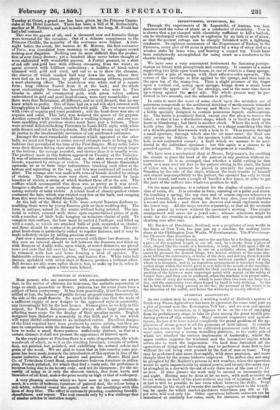GUIDEWAY AGRICULTURE.
As our readers may be aware, a working model of Halkett's system of Guideway Steam Agriculture has been in operation for some tune past on a plot of ground near the Kensington Toll bar ; and we now call special attention to the invention, as it appears to be on the eve of emerging from its probationary stage, to take its place among the great wealth pro- ducing powers of this country. Many eminent engineers and agricul- turists, declare it to have solved completely the grand problem of the ap- plication of steam power to all the processes of field labour. It consists in laying down on the land to be cultivated permanent rails fifty feet or more apart, carrying a strong travelling platform, to the under side of which are attached the various implements of husbandry, whilst the upper surface supports the workmen and the locomotive engine which serves also to work the implements. On land thus furnished all the operations of tillage and harvesting may be performed from first to last without the soil being ever pressed by the foot of man or beast. They may be performed also more thoroughly, with more precision, and more cheaply than by the means hitherto employed. The stiffest clay soil may be ploughed by Mr. Ilalkett's process in wet weather, when the operation would be quite impracticable by animal power, and twenty-live acres may be ploughed in a day with the aid of only three men at the cost of le. 7d. an acre. If time presses the work may be carried on incessantly day arid night. Hoeing may be done at 3d. an acre, with such accuracy as to cut within an inch of the plant without any risk of injuring it ; so thatl at last it will be possible to hoe even wheat between the drills. Deep cultivation (to the depth of twenty-five inches), equivalent to the trench- ing by spade for which market-gardeners sometimes pay 101. or 121. per acre, will cost only 12s. Other operations hitherto unknown can be introduced at similarly low rates, such, for instance, as underground watering, by which water or liquid manure may be applied to the roots of plants at any desired depth, so as to prevent the caking of the soil and other injurious effects resulting from surface watering, and to econo- mise the fluid by not exposing it to evaporation. Sixty acres per day may be thus treated for Is. an acre at the rate of 3000 gallons to each. The cost of the other processes will be—drilling 5d. per acre ; scarifying and grubbing, 8d.; harrowing and rolling, 5d.; reaping, cutting, and de- livering, 1061.; carriage and distribution of manure, Id. per ton per mile. All those prices have been verified by Mr. Braithwaite, C.E., who re- ports that the system may be employed "with great economy in labour
and immense advantage in an agricultural point of view." There can be no question," he says, "as to its ultimate success."
The additional outlay which Mr. Halkett's system will involve com- prises only the cost of the permanent rails, for the cost of the machinery and implements is about equal to that of horses and horse implements for similar work. The rails may be either of creosoted timber or of angle iron laid on brick work, the former costing 101., the latter 201. per acre. Large as this outlay appears, it cannot be regarded as an obstacle to the general adoption of a system which shall yield more than propor- tionate profits, both in the way of diminished cost of labour and greatly increased produce. Mr. Braithwaite speaks•without hesitation of the "enormous profits" which it "will be certain to realize."



































 Previous page
Previous page